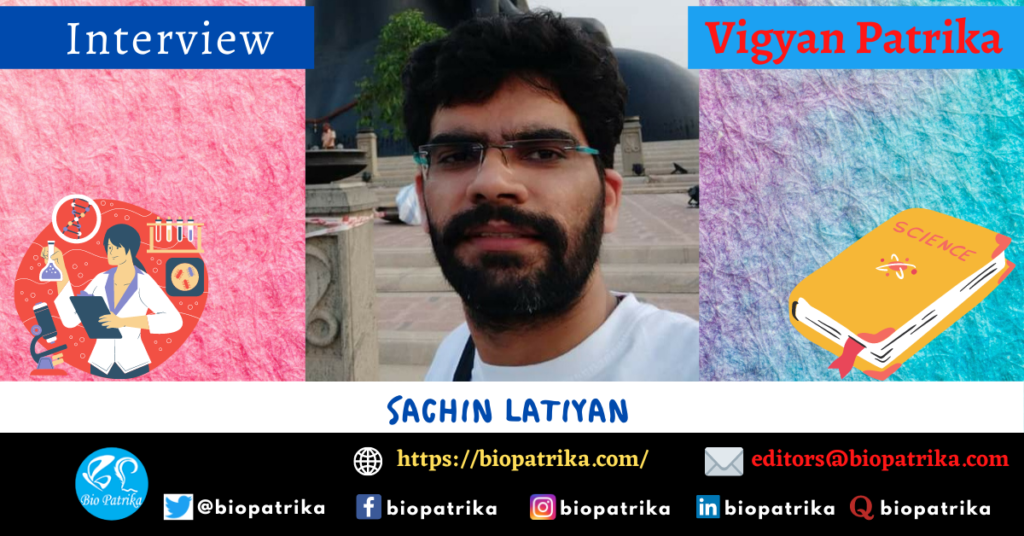Sachin Latiyan’s interview with Bio Patrika hosting “Vigyan Patrika”, a series of author interviews. Sachin is currently a doctoral candidate in the Metallurgical and Materials Engineering (MME) department at Medical Materials Laboratory (MML), Indian Institute of Technology, Madras (IITM). He is working in the field of biomaterials under the joint guidance of Prof. T.S. Sampath Kumar and Prof. Mukesh Doble. He did his M. Tech research at the Indian Institute of Sciences (IISc) on ‘Magneto-conducting multifunctional Janus microbots for intracellular delivery of biomolecules’ at BSSE (Functional Materials Laboratory) IISc under the supervision of Dr. Shilpee Jain. He holds interdisciplinary research experience in areas like Microfabrication (Photolithography), Biomaterials (electrospinning and electrospray), Nanomaterials (synthesis and characterization), Polymers, and Composites (GO-Magnetite), etc. Presently, he is working on the fabrication of nanofibrous scaffolds for wound healing and drug delivery applications. Here, Sachin talks about his work on “Magneto‐conducting multifunctional Janus microbots for intracellular delivery of biomolecules” published in J Tissue Eng Regen Med (2021).
How would you explain your paper’s key results to the non-scientific community?
During the last few decades, there have been rapid transformations within the existing technologies used to cure diseases (tuberculosis, cancer, etc.). In terms of targeted delivery of therapeutic payloads, various natural and artificial delivery vehicles are being used and investigated, such as liposomes and nanoparticles. To address the limitations (immune activation, short life, or limited energy source to move in body fluids, etc.) associated with such delivery systems, we have fabricated dual nature (i.e., magneto-conducting) Fe3O4 – SU8 based Janus microbots. The concept of using such microbots for intracellular delivery of therapeutic payloads can be dated back to one of the well-known fiction movies, ‘Fantastic Voyage’ (1966) and Richard Feynman’s far-sighted vision (1959).
These microbots possess head (magnetic and conducting) and tail (conducting) architecture for better steering within body fluids. They can deliver the therapeutic payloads intracellularly with the help of both electric as well as magnetic fields. These microbots are micron-sized, so they can be easily navigated through the body’s circulatory system (blood vessels). Moreover, these microbots are intrinsically fluorescent and hence can be easily traced without using any dye (such as injected by doctors within patients to get a better view of MRI scans) during payload delivery.

What are the possible consequences of these findings for your research area?
One of the most investigated diseases with any targeted therapy is cancer. This is because of the fact that in conventional chemotherapy, the cytotoxic drug(s) kill not only the cancer cells but normal cells too. With targeted delivery of drugs, we can selectively destroy the cancer cells, and the normal cells can be spared from these drugs. This would result in a significant reduction in adverse effects of the drugs. Moreover, this targeted delivery method can also be explored to deliver other cargos as well, such as nucleic acids and protein/peptide therapeutics. STEM cell migration can also be facilitated following the proper and desired functionalization of the designed vehicle. Secondly, these microbots are intrinsically fluorescent, so the usage of harmful dyes for tracking their navigation within the body can be avoided. Also, being magnetic in nature, we can exploit their hyperthermia property for destroying the cancer cells (not yet explored by us). Lastly, this article can provide some insights for developing future cargo delivering agents.
microbots are intrinsically fluorescent, so the usage of harmful dyes for tracking their navigation within the body can be avoided.
What was the exciting moment (eureka moment) during your research?
I assume that whole of the time spent at BSSE, IISc Bengaluru, during this study was the eureka time. But to answer specifically, then it was the fabrication of these microbots (~ 2-4 μm) since the photolithography technique used itself has a size limitation (1μm lowest possible). The second was when we observed their propulsion under electric and magnetic fields with the aid of a microscope.
What do you hope to do next?
The present study was limited to fabrication and in vitro studies. The next goal will be to perform hyperthermia and uptake studies in several other cell lines and explore the microbots’ behavior within a suitable animal model.
Where do you seek scientific inspiration?
Genuinely speaking, during the initial year of my master’s program, I was aware of the scientific work, but the keen scientific inspiration that I developed was after joining the BSSE, IISc under Dr. Shilpee Jain. I learnt many things from my supervisor during the tenure, such as planning experiments, executing and reporting scientific findings with minimal wastage of time, resources, and energy. Thanks to her as well as her team for all the support!
How do you intend to help Indian science improve?
As far as contribution to Indian Science is concerned, I would like to focus on biomedical innovations from the lab to the bedside. With my skills and interest, I would also like to propagate science to non-science people as a part of effective science communication.
Reference
Sachin Latiyan, Kaushik Suneet, Shilpee Jain. Magneto‐conducting multifunctional Janus microbots for intracellular delivery of biomolecules. J Tissue Eng Regen Med. 2021. https://doi.org/10.1002/term.3199
Edited by: Ashwini Kumar
